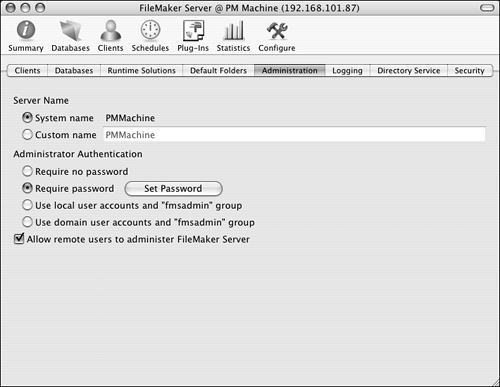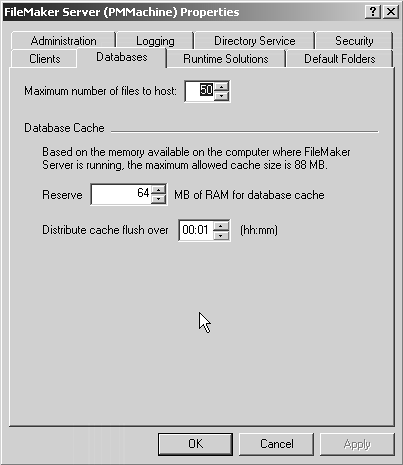Configuring and Administering FileMaker Server Using the SAT
| < Day Day Up > |
| You use the SAT tool to set up and maintain a number of important properties of a FileMaker Server installation. We cover here what we consider to be the most critical areas. The supplied documentation provides comprehensive coverage of the remaining features. Server Administration SettingsOn the Administration tab of the SAT you can set some options that control administrative access to the server. In particular, you can choose the method by which administrators must authenticate, as well as specify whether remote administration of FileMaker Server is possible, as shown in Figure 25.4. Figure 25.4. Use the Administration area of the SAT to control administrative access to the server. You should always require a password for server administration (and this should go without saying). You have the option, though, of using a non-FileMaker authentication source. You can instruct FileMaker Server to authenticate administrators against a user group called fmsadmin . You can choose to look for such a group among the accounts that are local to the specific machine, or to look among the accounts for whatever domain in which the server machine participates, if any. Also on this tab you can control whether to allow remote administration of this instance of FileMaker Server. If this box is unchecked, FileMaker Server can be administered only by a copy of SAT running on the same machine. You need to enable this option if you want to administer FileMaker Server from a copy of the SAT running on a remote machine. Resource Usage SettingsThe SAT has a number of settings that control the resources that FileMaker Server sets aside for certain tasks . On the Clients tab of the SAT, you can specify the maximum number of FileMaker Pro and Web clients that can be connected at one time, and on the Databases tab you can control the maximum number of files that FileMaker Server will try to open. (The Clients tab was shown previously in Figure 25.2. The Databases tab is shown in Figure 25.5.) All these numbers have a hard upper limit: 250 for simultaneous FileMaker Pro or ODBC/JDBC users, 100 for simultaneous Web clients , and 125 for the maximum number of open files. If you know that your loads will be lower than those figures, though, you can lower the numbers. If you'll never need to have more than 50 files open , or more than 25 users, you can set these thresholds lower. Doing so frees up resources, such as RAM, that FileMaker Server would otherwise need to keep in reserve for the possible higher loads. As a general rule, you should set these three numbers as low as you can. Figure 25.5. Use the Databases area to control file hosting and cache size limits. You can also specify the amount of RAM to set aside for a database cache. This value is configured on the Databases tab. The SAT lets you know what it thinks the maximum allowable cache size is, based on total available RAM. It's tempting to think you should just set the database cache to the largest possible size, but this isn't always the best option. Setting aside too large a cache can take RAM from other areas, such as the operating system, without necessarily being beneficial to FileMaker Server. It's probably safe to say that your cache should never need to be much bigger than the total size of all your served databases. So if you're serving files that total 100 megabytes in size, there's probably not much point to a 300-megabyte cache, even if you have enough RAM to support a cache of that size. Client Connectivity SettingsThe Clients tab of the SAT also lets you specify additional connectivity options for an installation of FileMaker Server Advanced. Here you can allow or disallow ODBC and JDBC connections, and configure connections to a Web Publishing Engine. These options are fully explored in other chapters. |
| < Day Day Up > |

 For a discussion on ODBC and JDBC,
For a discussion on ODBC and JDBC,